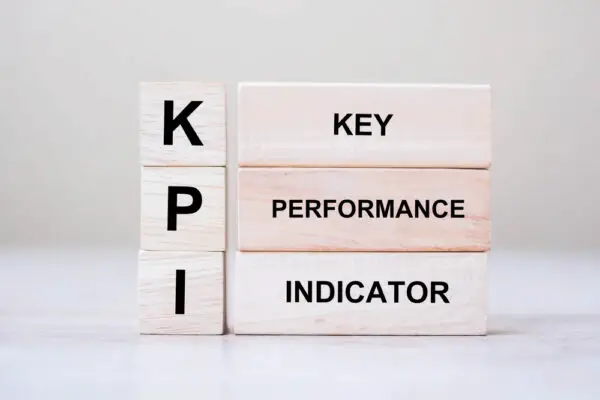Key Production Indicators (KPIs) are crucial in manufacturing as they provide quantifiable metrics that help businesses assess their production performance, identify areas for improvement, and make informed decisions.
They are vital for understanding operational efficiency, productivity, and the overall health of the manufacturing process.
For instance, Overall Equipment Effectiveness (OEE) is a widely used KPI that combines availability, performance, and quality to provide insight into how well equipment is utilized.
Another important KPI is Throughput, which measures the amount of product produced in a given period of time, indicating the speed of production.
Lead Time is also critical, as it tracks the time taken from initiating a process to its completion, influencing customer satisfaction and inventory management.
KPIs like Work-in-process (WIP), On-time-in-full (OTIF) delivery, and Cost Per Unit (CPU) further help manufacturers monitor production efficiency, supply chain effectiveness, and cost control.
Manufacturers can gain a comprehensive view of their operations, drive continuous improvement, and achieve competitive advantage by tracking KPIs.
Organizations use Key Performance Indicators (KPIs) to measure progress toward achieving their key business objectives.
These metrics can be applied to any aspect of a business, from manufacturing to sales and marketing, and can be used to track performance over time.
Organizations can optimize their operations by identifying improvement areas through KPIs and regular progress monitoring.
Understanding KPIs is crucial for any organization looking to improve its performance.
If you’re managing a business, selecting the most relevant metrics for your operations and establishing KPI targets is important.
Setting KPI targets is an essential part of the process. Organizations can ensure their employees are motivated and working towards specific, measurable goals.
KPI targets should be specific, measurable, and relevant to the organization’s overall objectives.

Regularly reviewing progress against these targets is vital, as it allows organizations to identify areas where they are falling short and take corrective action.
Key Takeaways
- KPIs are measurable values that organizations use to track performance and identify areas for improvement.
- KPIs measure different aspects of a business, from operational efficiency to customer satisfaction.
- Setting clear, achievable KPI targets is crucial for motivating employees and ensuring everyone works towards the same goals.
Understanding KPIs
Defining KPIs
Key Performance Indicators (KPIs) are measurable, quantifiable measures organizations use to evaluate their success in achieving their objectives.
KPIs are used to track progress towards specific goals and targets, and they provide a way to measure performance over time.
KPIs can be used to evaluate performance at the organizational level, department level, or individual level.
KPIs are typically chosen because they are relevant to a specific business objective and they are measurable.
KPIs should be chosen based on the organization’s overall strategy and goals. Some common KPIs include revenue growth, customer satisfaction, employee satisfaction, and operational efficiency.
Importance of KPIs
KPIs are important because they provide a way to measure progress towards specific goals and targets.
They help organizations to identify areas where they are performing well and areas where they need to improve.
KPIs also provide a way to track trends over time and identify performance changes.
KPIs are particularly important in production environments, where efficiency and productivity are critical to success.
By tracking KPIs such as cycle time, defect rate, and equipment downtime, organizations can identify areas where they can improve their processes and increase productivity.
KPIs can also be used to track the performance of individual employees or teams, which can help to identify areas where additional training or support may be needed.
KPIs are critical for measuring performance and tracking progress towards specific goals and targets.
They provide a way to identify areas where improvements can be made, and they help organizations stay focused on their overall strategy and objectives.
Setting KPI Targets
Establishing goals and benchmarks is a critical step in setting KPI targets. KPI targets should be specific, achievable, and time-bound.
Establishing Goals
To establish goals, companies should first identify their general aims. Once they have defined their general aims, it is time to define their KPI targets.
To help with this task, companies can start by defining the key performance indicators they will track.
One way to establish goals is to use KPI standards. Using KPI standards can help companies set realistic goals based on industry benchmarks.
For example, a manufacturing company may set a goal to reduce their production costs by 10%, a common industry benchmark.
Another way to establish goals is to use the SMART framework. The SMART framework stands for specific, measurable, achievable, relevant, and time-bound.
This framework can help companies set specific, measurable, and achievable goals within a specific timeframe.
Benchmarking Targets
Once companies have established their goals, they can benchmark their targets. Benchmarking targets involves comparing a company’s performance to industry standards or competitors.
Benchmarking targets can help companies set achievable targets within their industry.
For example, a manufacturing company may benchmark its production efficiency against its competitors to set a realistic target for its own production efficiency.
setting KPI targets requires establishing goals and benchmarking targets.
Companies should use KPI standards or the SMART framework to establish their goals and benchmark their targets against industry standards or competitors.
Companies can improve their performance and achieve their goals by setting specific, achievable, and time-bound targets.

Operational KPIs
Operational KPIs are essential to track the efficiency of day-to-day operations in a manufacturing plant.
These quantifiable metrics help evaluate business performance and provide valuable insights into key areas of operations. Two critical operational KPIs are Efficiency Metrics and Production Capacity.
Efficiency Metrics
Efficiency Metrics are key performance indicators that measure the effectiveness of the manufacturing process.
These metrics can be used to track the time it takes to complete a task, the amount of resources used, and the quality of the output. By monitoring efficiency metrics, manufacturers can identify areas of improvement and optimize their operations.
One of the most commonly used efficiency metrics is cycle time. Cycle time measures the time it takes to complete a task, from start to finish.
This metric can be used to identify bottlenecks in the production process and optimize the workflow.
Another important efficiency metric is productivity, which measures the output per input unit. By tracking productivity, manufacturers can identify areas where they can increase output without increasing input.
Production Capacity
Production Capacity is another critical operational KPI that manufacturers need to track.
Production Capacity measures the maximum output that a manufacturing plant can produce over a given period.
Capacity Utilization is another important metric that measures the percentage of a plant’s production capacity that is being used.
By tracking Production Capacity and Capacity Utilization, manufacturers can optimize their operations and ensure they produce as much as possible.
To summarize, operational KPIs are essential for monitoring the efficiency of day-to-day operations in a manufacturing plant.
By tracking Efficiency Metrics and Production Capacity, manufacturers can identify areas for improvement and optimize their operations to increase output and reduce costs.
Financial KPIs
Financial KPIs are critical metrics that help businesses monitor their financial performance and identify areas that require improvement.
These metrics track and analyze the company’s financial health and progress toward its goals.

Profitability Metrics
Profitability metrics are used to measure the company’s ability to generate profits. These metrics include net profit, profit margin, and gross profit margin.
Net profit is the difference between total revenue and total expenses. Profit margin is the ratio of net profit to total revenue, while gross profit margin is the ratio of gross profit to total revenue.
To improve profitability, businesses can focus on increasing revenue, reducing expenses, or combining both.
For example, a business can increase revenue by launching new products or expanding into new markets.
On the other hand, a business can reduce expenses by optimizing its operations, negotiating better deals with suppliers, or reducing overhead costs.
Investment Returns
Investment returns measure the company’s ability to generate returns on its investments.
These metrics include return on investment (ROI) and return on equity (ROE). ROI is the ratio of net profit to the total investment, while ROE is the ratio of net profit to shareholders’ equity.
To improve investment returns, businesses can focus on increasing revenue, reducing expenses, or optimizing their investments.
For example, a business can increase revenue by investing in new products or technologies that have a high growth potential.
On the other hand, a business can reduce expenses by optimizing its operations or reducing overhead costs.
Finally, a business can optimize its investments by diversifying its portfolio, investing in low-risk assets, or investing in assets that have a high growth potential.
Quality and Performance KPIs
Quality and performance are two of the most critical aspects of production in companies.
Key Performance Indicators (KPIs) can help track and measure the performance of such abstract and complex subjects. KPIs can also help reach the right results and identify areas for improvement.
Product Quality
Product quality is a crucial KPI that measures the number of products that meet the required quality standards.
It is important to ensure that the products meet the quality standards set by the company and the customers.
The first pass yield (FPY) is a useful KPI that measures the percentage of products that pass the quality check on the first attempt.
A high FPY indicates that the production process is efficient and effective.
Service Excellence
Customer satisfaction is a vital KPI that measures the level of satisfaction of the customers with the products and services offered by the company.
A satisfied customer is likelier to become a repeat customer and recommend the company to others. Therefore, it is important to measure customer satisfaction regularly and take action to improve it.
Overall Equipment Effectiveness (OEE) is another KPI that measures the efficiency of the equipment and machines used in the production process.
It takes into account three factors – availability, performance, and quality – and provides a holistic view of the equipment’s effectiveness.
Quality and Performance KPIs are essential for companies to track and measure the quality of the products and services they offer.
By using KPIs such as FPY, customer satisfaction, and OEE, companies can identify areas for improvement and take action to improve their production processes.
Customer-Centric KPIs
In today’s business world, customer satisfaction is crucial for success. Therefore, it is essential to track the performance of customer-centric KPIs to ensure customer satisfaction and retention. Here are two key customer-centric KPIs that businesses should monitor:
Customer Service Metrics
Customer service metrics are essential for measuring the quality of service offered to customers.
They include metrics such as first response time, resolution time, and customer satisfaction score. First, response time is the time taken to respond to a customer’s query, and resolution time is the time taken to resolve the issue.
A high customer satisfaction score indicates that the customers are happy with the service provided.
According to Hubspot, businesses should aim to keep the first response time under 24 hours and the resolution time under 48 hours.
Additionally, businesses should aim for a high customer satisfaction score, which can be achieved by addressing customer queries promptly and effectively.
Market Share and Retention
Market share and retention are essential customer-centric KPIs that businesses should monitor. Market share is the percentage of the total market that a business holds.
A high market share indicates that the business is doing well in the market. Retention rate, on the other hand, is the percentage of customers who continue to do business with a company over a given period.
A high retention rate indicates customers are satisfied with the product or service.
According to Forbes, businesses should focus on customer retention for long-term success. By keeping customers satisfied, businesses can improve their retention rate and increase their market share.
Measuring customer-centric KPIs is essential for businesses to ensure customer satisfaction and retention.
By monitoring customer service metrics and market share and retention, businesses can improve their customer-centric approach and achieve long-term success.

Manufacturing KPIs
Manufacturing Key Performance Indicators (KPIs) are essential metrics used to track and measure the performance of the production process.
These metrics help manufacturing companies to identify areas of improvement, optimize operations, and increase profitability.
In this section, we will explore two important categories of manufacturing KPIs: Production Efficiency and Maintenance and Downtime.
Production Efficiency
Production Efficiency is a crucial aspect of manufacturing operations. It measures how well a company utilizes its resources to produce goods.
One of the most commonly used Production Efficiency KPIs is Overall Equipment Effectiveness (OEE). OEE measures the percentage of time that equipment is operating effectively. It takes into account three factors: Availability, Performance, and Quality.
Another important Production Efficiency KPI is Planned Maintenance Percentage. This metric measures the percentage of time that equipment is down for planned maintenance.
It is a critical KPI because it ensures that equipment is always in good condition and reduces the likelihood of unplanned downtime.
Maintenance and Downtime
Maintenance and Downtime are also critical aspects of manufacturing operations. Downtime is when equipment is not operating due to unplanned maintenance, repairs, or other issues.
It is a significant cost for manufacturers because it can lead to lost production time, decreased productivity, and increased operating costs.
One of the most important KPIs for measuring Maintenance and Downtime is Downtime Percentage.
This metric measures the percentage of time that equipment is down due to unplanned maintenance or repairs.
It is a crucial KPI because it helps manufacturers to identify areas of improvement and reduce downtime.
Manufacturing KPIs are essential for measuring and optimizing the performance of the production process.
By tracking and analyzing these metrics, manufacturers can identify areas of improvement, reduce costs, and increase profitability.
Sales and Marketing KPIs
Key Performance Indicators (KPIs) are a vital tool for businesses to measure their performance and identify areas for improvement.
Sales and marketing KPIs are particularly important as they help businesses to track their revenue generation, customer acquisition, and market share.
In this section, we will discuss some of the most important sales and marketing KPIs that businesses should track.
Sales Performance
Sales performance is a critical aspect of any business, and tracking KPIs related to sales can help businesses to improve their revenue generation.
One of the most important sales KPIs is the conversion rate, which measures the percentage of leads converted into paying customers.
Other important sales KPIs include the average order value, the number of sales per representative, and the sales growth rate.
Marketing Effectiveness
Marketing effectiveness is another important area for businesses to track, as it directly impacts revenue generation and customer acquisition.
One of the most important marketing KPIs is website traffic, which measures the number of visitors to a business’s website.
Other important marketing KPIs include the customer acquisition cost (CAC), which measures the amount of money it takes to acquire a new customer, and the market share, which measures a business’s share of the overall market.
Tracking sales and marketing KPIs is essential for businesses to improve their revenue generation, customer acquisition, and market share.
By tracking these KPIs, businesses can identify areas for improvement and make data-driven decisions to optimize their sales and marketing strategies.
Strategic KPIs
Strategic KPIs are a set of metrics that are designed to measure how well an organization is achieving its long-term objectives and strategic goals.
These indicators help the organization understand whether it is on track to achieve its strategic goals or whether it needs to make changes to its strategy.
Long-Term Objectives
Long-term objectives are the overarching goals that an organization wants to achieve over a period of several years.
These objectives are usually focused on growth, profitability, and market share. To achieve these objectives, the organization needs to develop a clear strategy that outlines how it will achieve its goals.
Strategic KPIs can help the organization measure how well it is achieving its long-term objectives.
For example, if the organization’s long-term objective is to increase its market share, it can use KPIs such as market share percentage, customer acquisition rate, and customer retention rate to measure its progress.
Competitive Positioning
Competitive positioning is a critical aspect of any organization’s strategy. It involves understanding the competitive landscape and positioning the organization to compete effectively.
To achieve a strong competitive position, the organization needs to have a clear understanding of its strengths and weaknesses relative to its competitors.
Strategic KPIs can help the organization measure its competitive positioning. For example, if the organization’s strategy is to differentiate itself from its competitors based on product quality, it can use KPIs such as product defect rate, customer satisfaction rate, and product return rate to measure its progress.
Strategic KPIs are critical in helping organizations achieve their long-term objectives and competitive positioning.
By measuring key metrics and using this information to make strategic decisions, organizations can ensure they are on track to achieve their goals and remain competitive in their respective markets.
KPI Reporting and Analysis
KPI reporting and analysis is an essential process for any organization that wants to track and improve its performance over time.
It involves collecting data, analyzing it, and presenting it in a way that is easy to understand and act upon.
Data Visualization
One of the key aspects of KPI reporting and analysis is data visualization. This involves presenting data in a visual format, such as charts, graphs, and tables.
Data visualization helps to make complex data sets more accessible and easier to understand.
It also allows stakeholders to identify trends and patterns more quickly, enabling them to make informed decisions.
Making Informed Decisions
KPI reporting and analysis are critical for making informed decisions. By tracking key performance indicators, organizations can identify areas where they are performing well and areas where they need to improve.
This information can then be used to make data-driven decisions that will help to improve overall performance.
To make informed decisions, it is essential to have accurate and up-to-date data. This requires a robust data collection process that ensures data is collected consistently and accurately.
Once data has been collected, it can be analyzed and presented in a way that is easy to understand.

This can be done using KPI dashboards, which provide a real-time snapshot of an organization’s performance.
KPI reporting and analysis is a critical process that enables organizations to track and improve their performance over time.
By collecting and analyzing data, and presenting it in a way that is easy to understand, organizations can make informed decisions that will help them to achieve their goals.

Chris Ekai is a Risk Management expert with over 10 years of experience in the field. He has a Master’s(MSc) degree in Risk Management from University of Portsmouth and is a CPA and Finance professional. He currently works as a Content Manager at Risk Publishing, writing about Enterprise Risk Management, Business Continuity Management and Project Management.


